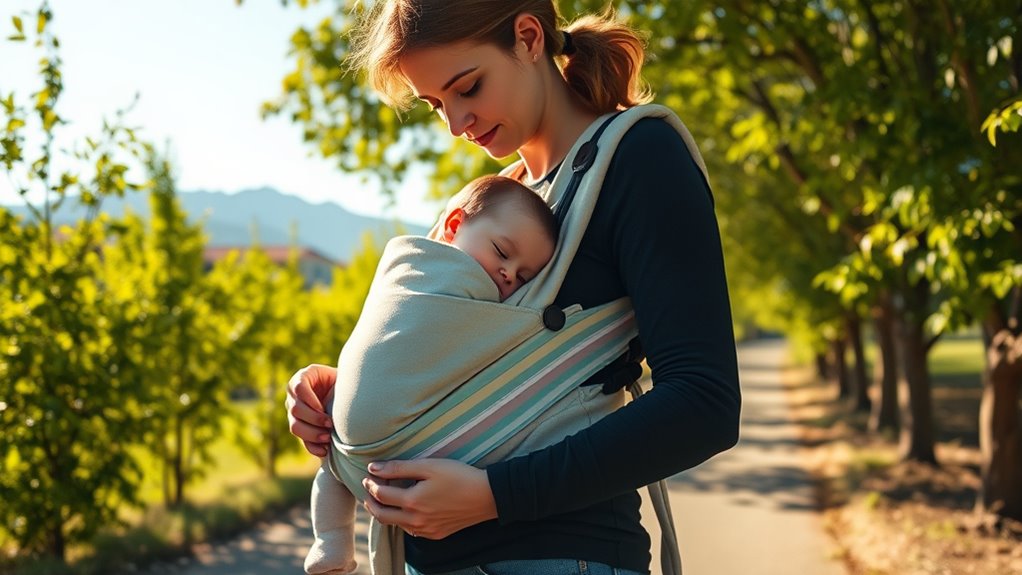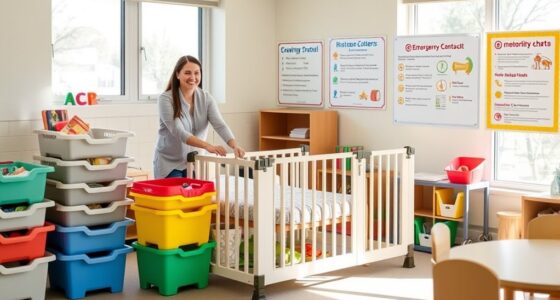When traveling with a baby under 6 months, plan ahead by packing essentials like diapers, wipes, and extra clothes, and bringing copies of important documents. Choose a transportation option suited to your destination, guaranteeing car seats are secure or airline policies are met. Keep feeding supplies, comfort items, and diapers within reach, and monitor temperature and your baby’s cues to ensure comfort and safety. For helpful tips to make your trip smoother, continue exploring the best practices for traveling with your little one.
Key Takeaways
- Prepare all essential documents, supplies, and comfort items in an organized, easily accessible bag for smooth travel.
- Choose transportation based on distance and baby’s needs, ensuring proper safety measures like correct car seat installation.
- Keep feeding, diapering, and soothing supplies within reach to handle messes and comfort the baby during delays.
- Maintain a comfortable environment by controlling temperature, dressing appropriately, and monitoring for signs of discomfort.
- Arrive early, stay flexible, and keep essentials handy to ensure a stress-free, safe journey with your baby.
Preparing for the Trip: Packing Essentials and Documentation
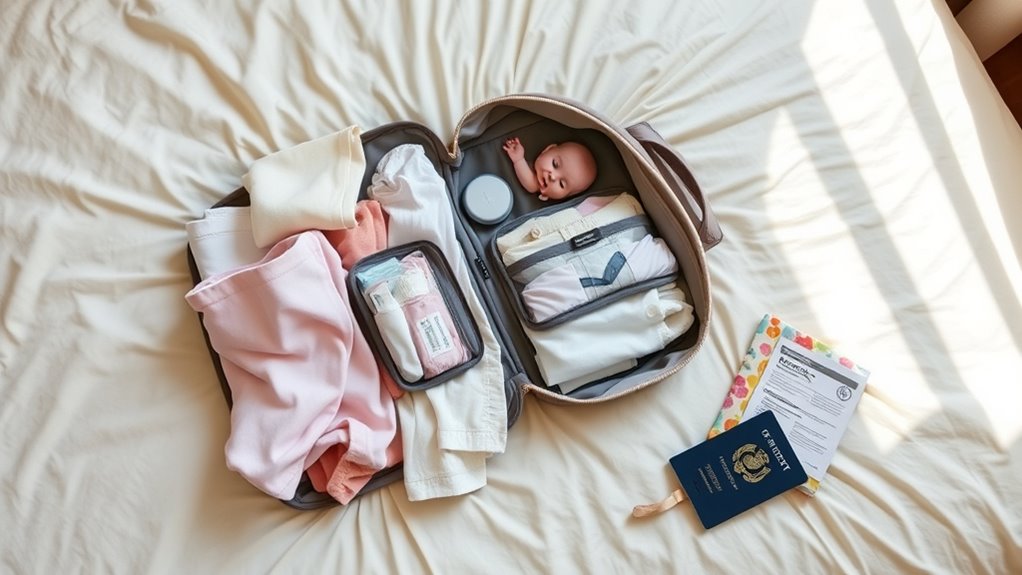
Before you head out, make sure you have all the essentials packed and your documentation in order. Pack enough diapers, wipes, and changing supplies to last the trip, plus a few extras just in case. Bring along your baby’s favorite blanket and a small selection of clothes suitable for different weather conditions. Don’t forget bottles, formula or breast pump accessories, and any medications your baby might need. Carry copies of important documents like birth certificates, health insurance cards, and vaccination records. It’s also wise to have a list of emergency contacts and your pediatrician’s info handy. Organizing everything in a dedicated bag for quick access, so you’re prepared for any situation that might arise during your journey. Remember to include safe sleep practices in your preparations to ensure your newborn’s safety during travel.
Choosing the Right Transportation Method
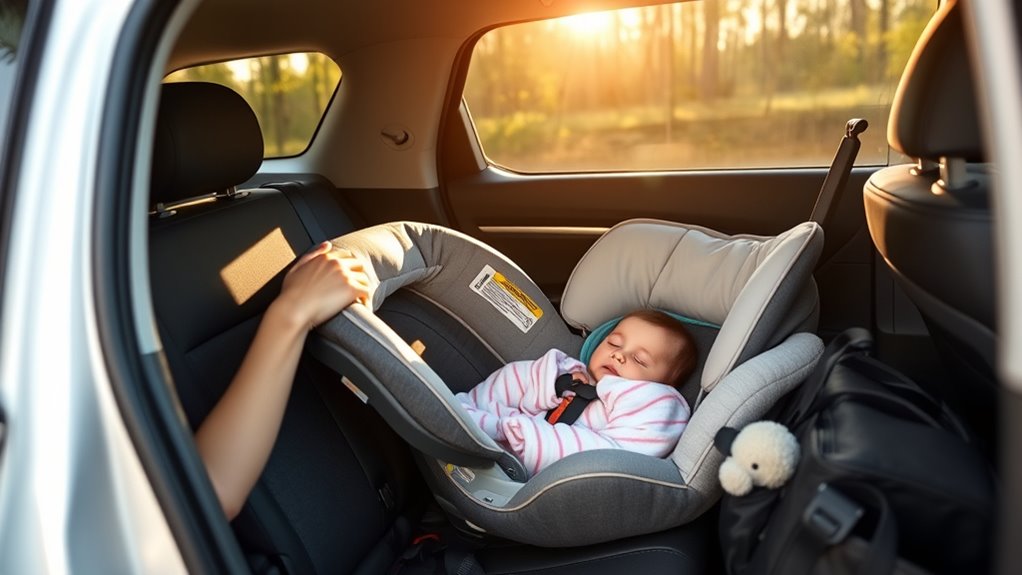
Choosing the right transportation method can make a significant difference in your travel experience with a baby under 6 months. Consider your destination’s distance, your comfort level, and your baby’s needs. Car travel offers flexibility and convenience, allowing you to stop easily for feedings and diaper changes. If you opt for a plane, check airline policies on infants and select seats with extra legroom or bassinets if available. Trains can be a smooth, spacious option, especially for short trips, and often have quieter environments. Keep safety in mind—ensure your car seat is properly installed and approved. Think about ease of access, comfort, and how well the method accommodates your baby’s routine. Being aware of your privacy policy and how your data is handled can ensure a stress-free travel planning experience. The right choice will help you travel more comfortably and confidently.
Managing Feedings and Diaper Changes on the Go
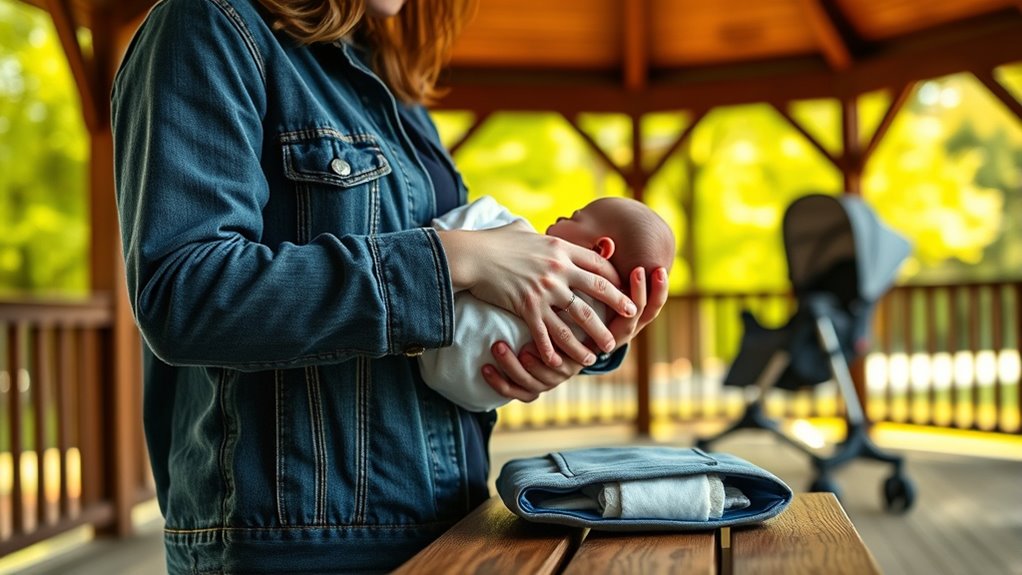
When you’re on the move, having the right gear makes feeding and diaper changes smoother. Keep a portable feeding kit and a well-stocked diaper bag within easy reach. Be prepared for blowouts with quick-clean supplies to handle surprises efficiently.
Portable Feeding Gear Tips
Carrying portable feeding gear makes managing feedings and diaper changes easier while traveling with your baby under 6 months. Opt for a compact, all-in-one kit with bottles, formula or breast milk, and a bottle brush. Use insulated bags to keep milk fresh and easily accessible. Pre-measure formula or have ready-to-use bottles to save time. Bring a portable bottle warmer or a thermal pouch to warm milk on the go. For diaper changes, pack a small changing pad that fits in your bag, along with extra wipes and diapers. Keep everything organized in a dedicated compartment for quick access. This setup minimizes fuss and helps you stay prepared, ensuring your little one stays fed and comfortable during your trip. Recognizing the importance of angel number soulmates can also bring reassurance and positive energy during travel.
Diaper Kit Essentials
Having a well-stocked diaper kit is essential for managing feedings and diaper changes smoothly while you’re on the go. Make sure it contains enough diapers for the trip, plus a few extras in case of delays. Pack wipes that are gentle on your baby’s skin, and consider a changing pad for sanitary surfaces. Include a small container of diaper cream to prevent irritation. Don’t forget a plastic bag or disposable waste bag for dirty diapers. Keep a change of clothes handy in case of leaks or accidents. If you’re using cloth diapers, bring the necessary supplies for quick changes. Being aware of projector technology can also help you choose the best setup for your home theater, making your viewing experience more enjoyable. Having these essentials organized and accessible makes diaper changes faster and less stressful, keeping your baby comfortable and your trip enjoyable.
Managing Diaper Blowouts
Ever wondered how to handle a diaper blowout while out and about? It’s common, but staying calm makes it easier. First, find a clean, flat surface—like a changing pad or a bench. Keep your diaper kit ready with extra wipes, a clean diaper, and plastic bags for disposal. Quickly unfasten the soiled diaper, wipe your baby thoroughly, and fold the dirty diaper inside a plastic bag. Slide on a fresh diaper, ensuring a snug fit. Always check for leaks afterward, and don’t forget to wash your hands or use sanitizer. Staying prepared and quick will make blowouts less stressful. Remember, an organized diaper bag can save you time and hassle during these situations.
Ensuring Comfort and Safety During Travel
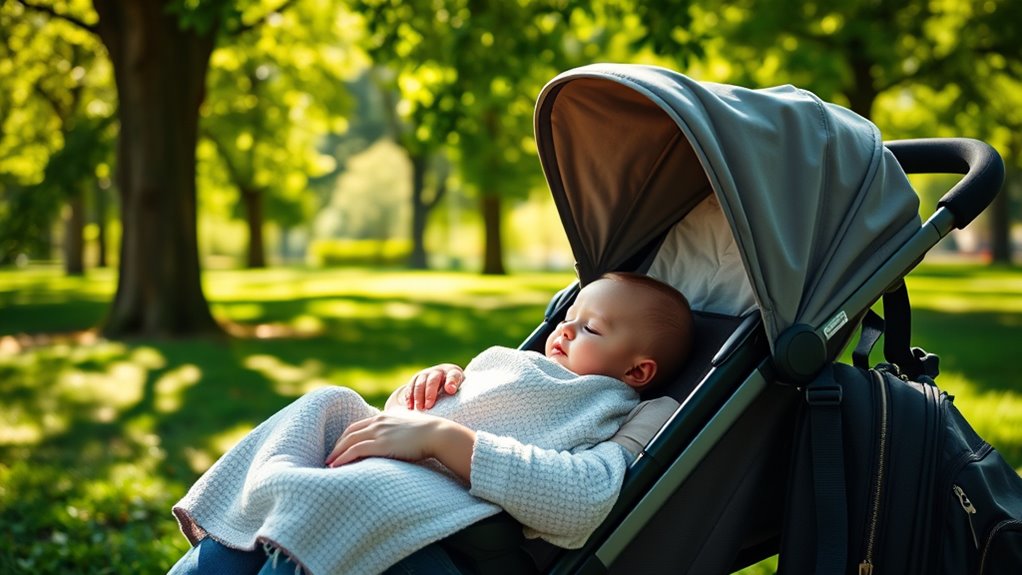
To keep your baby safe and comfortable during travel, start by securing the car seat properly and ensuring it’s at the right angle. Keep the temperature comfortable to prevent overheating or chilling, and always have essential supplies like diapers, wipes, and a blanket within reach. Taking these steps helps make the journey smoother and more secure for your little one. Additionally, being aware of symptoms of discomfort can help you respond quickly if your baby shows signs of illness or distress.
Secure Car Seat Placement
Making sure your baby’s car seat is properly secured is essential for both their safety and comfort during travel. Double-check that the harness is snug, with no slack, and that the chest clip is at armpit level. Make certain the seat is firmly installed, either using the seat belt or LATCH system, and doesn’t wobble when tested. Position the seat at the correct recline angle for your baby’s age to keep their airway open. Always verify that the car seat is facing the rear, as recommended for infants. Regularly inspect the installation throughout your trip to prevent shifting. Additionally, ensure the car seat’s proper placement supports the baby’s developmental needs and safety standards.
Maintain Temperature Comfort
Maintaining a comfortable temperature for your baby is essential for a safe and pleasant trip. You want to prevent your little one from overheating or getting too cold, which can cause discomfort or health issues. Keep the car climate controlled, adjusting the air conditioning or heater as needed. Use a reliable thermometer to monitor the temperature inside the vehicle, aiming for around 68-72°F (20-22°C). Dress your baby in lightweight, breathable clothes, and consider layering so you can easily add or remove blankets or clothing. Avoid heavy blankets that could cause overheating. Regularly check on your baby’s comfort, and ensure their face and neck stay cool and dry. Staying attentive to temperature helps keep your baby safe, relaxed, and happy during your travels. Incorporating mindfulness techniques such as regularly checking your baby’s cues can help you stay attuned to their comfort levels throughout the journey.
Pack Essential Baby Supplies
Packing essential baby supplies is crucial for keeping your little one comfortable and safe throughout your trip. You want to be prepared for any situation, so bring along the basics. Make sure to pack enough diapers, wipes, and a changing pad for quick diaper changes. Bring a few extra bottles and formula or breast milk storage bags to keep your baby fed. Don’t forget a lightweight blanket and a pacifier to soothe your baby when needed. A small first aid kit with infant-safe supplies can help in emergencies. Finally, carry a spare outfit or two in case of spills or messes. Being prepared with these essentials ensures your baby stays happy, comfortable, and safe during your travels. Additionally, understanding vetted information about baby travel gear can help you choose the safest and most reliable products for your journey.
Navigating Airports and Security Checks With a Baby
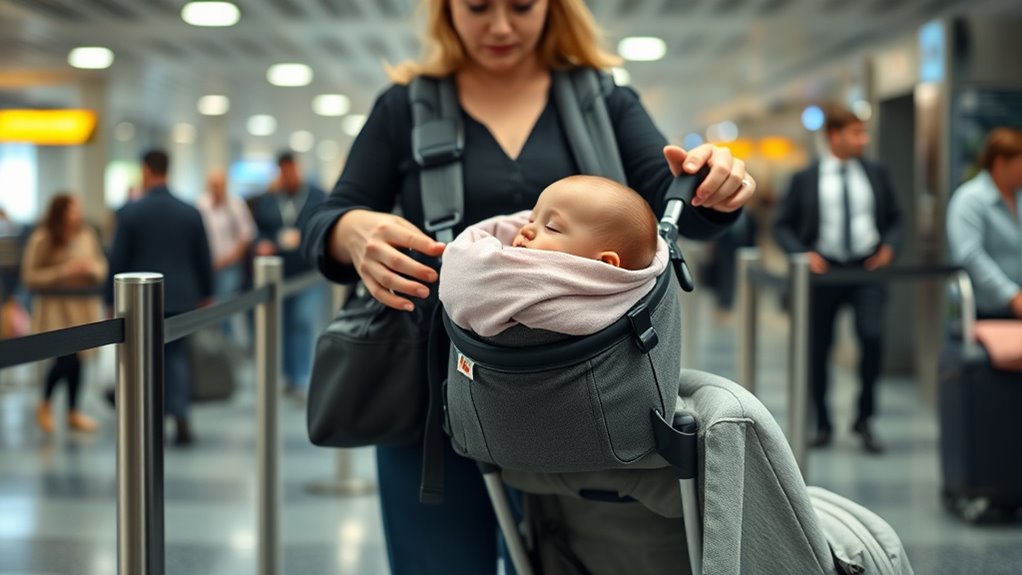
Traveling through airports with a baby under 6 months can feel overwhelming, but with a little preparation, the process becomes much smoother. Arrive early to allow plenty of time for security checks and potential delays. When you reach security, remove your baby from the carrier if needed, and place the carrier or stroller on the conveyor belt. Use the designated family or priority lanes if available to expedite the process. Keep your baby’s essentials, like formula or breast milk, easily accessible for screening. Be prepared for extra questions or inspections; calmly cooperate with security staff. Carry a familiar blanket or toy to soothe your baby during waits. Staying organized and calm helps make steering through airports less stressful for both of you. Incorporating professional equipment or familiar sounds can also help comfort your baby during travel.
Tips for Handling Common Travel Challenges With a Young Infant
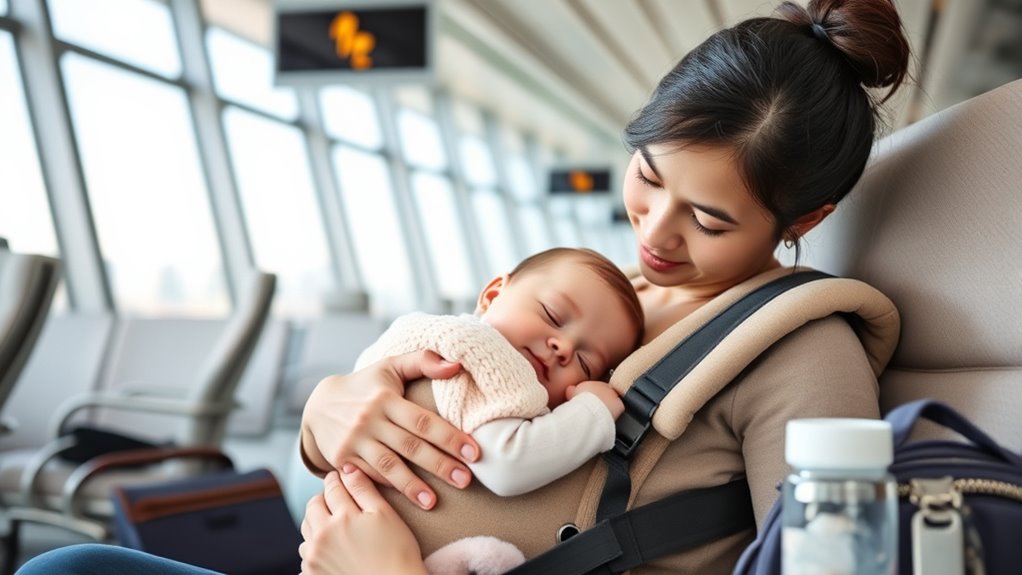
Even with careful planning at security checkpoints, traveling with a young infant often introduces unexpected challenges. Your baby might get fussy, hungry, or tired at the worst moments. Staying flexible and prepared can make a big difference. Bring extra essentials like diapers, wipes, and a change of clothes in your carry-on. Use familiar items such as a favorite blanket or toy to soothe your baby. Keep snacks and bottles handy to prevent hunger-induced crankiness. During delays, walk or gently sway your baby to calm them down. Remember to stay calm yourself; your mood influences your infant’s behavior.
- Keep soothing items within reach at all times
- Plan for extra bathroom breaks
- Use noise-canceling headphones if needed
- Prepare quick distraction tools
- Maintain a calm, reassuring presence
Frequently Asked Questions
How Can I Soothe a Crying Baby During Travel?
When your baby cries, try to identify the cause—hunger, discomfort, or fatigue. You can gently soothe them by rocking, singing, or offering a pacifier. Keep them close and secure in a snug carrier or car seat. Use white noise or calming music to create a familiar environment. Stay calm yourself, as your reassurance helps ease their distress, making travel more comfortable for both of you.
What Should I Do if My Baby Gets Sick While Traveling?
If your baby gets sick while traveling, stay calm and assess their symptoms. You should seek medical attention immediately if symptoms are severe, like high fever or difficulty breathing. Keep your baby hydrated, offer comfort, and monitor their condition closely. Carry their medical records and a first aid kit. Contact local healthcare providers or visit the nearest clinic if needed, ensuring your baby’s health and safety are the top priorities.
Are There Specific Travel Insurance Options for Infants?
Ever wondered if your little one has the right coverage? Yes, there are travel insurance plans designed specifically for infants, offering medical coverage, emergency assistance, and trip cancellations. You can choose policies that include pediatric care and support for unexpected illnesses. Don’t leave your baby’s health to chance—invest in a plan tailored for infants to guarantee peace of mind during your travels, knowing you’re protected no matter what happens.
How Do I Manage Jet Lag With a Young Baby?
Managing jet lag with a young baby can be challenging, but you can ease the process. You should gradually shift your baby’s sleep schedule before your trip, expose them to natural light during the day, and keep routines consistent. During travel, offer plenty of comfort and patience. Once you arrive, adapt to the new time zone quickly by aligning your baby’s naps and meals with local times, helping them adjust faster.
Can I Bring Baby Medication Through Security?
Before you breeze through security, be prepared. Yes, you can bring baby medication through security, but it’s best to pack them in your carry-on and keep them labeled. Be ready for potential screening and declare any liquids or gels. To make the process smooth, carry a doctor’s note if necessary, and organize medications for easy inspection. This way, you’ll confidently continue your caring journey with comfort and convenience.
Conclusion
Traveling with a baby under 6 months might seem overwhelming, but with the right planning, it’s totally doable. Remember, your little one can sense your calmness, so stay relaxed and flexible. Even if things don’t go perfectly, it’s all part of the adventure. Trust your instincts, pack smart, and enjoy the precious moments together. Before you know it, you’ll be creating memories that make all the effort worth it.
